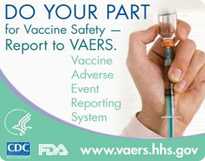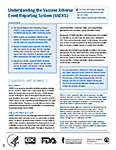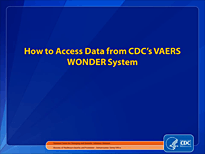Vaccine Adverse Event Reporting System (VAERS)
Introduction to VAERS
The Vaccine Adverse Event Reporting System (VAERS) is a national vaccine safety surveillance program run by CDC and the Food and Drug Administration (FDA). VAERS serves as an early warning system to detect possible safety issues with U.S. vaccines by collecting information about adverse events (possible side effects or health problems) that occur after vaccination.
VAERS was created in 1990 in response to the National Childhood Vaccine Injury Act. If any health problem happens after vaccination, anyone – doctors, nurses, vaccine manufacturers, and any member of the general public – can submit a report to VAERS.
How VAERS is Used
VAERS is used to detect possible safety problems – called “signals” – that may be related to vaccination. If a vaccine safety signal is identified through VAERS, scientists may conduct further studies to find out if the signal represents an actual risk.
The main goals of VAERS are to:
- Detect new, unusual, or rare adverse events that happen after vaccination
- Monitor increases in known side effects, like arm soreness where a shot was given
- Identify potential patient risk factors for particular types of health problems related to vaccines
- Assess the safety of newly licensed vaccines
- Watch for unexpected or unusual patterns in adverse event reports
- Serve as a monitoring system in public health emergencies
How to Report Adverse Events to VAERS
There are three ways to submit a report to VAERS:

-
Report Online
Complete a VAERS form online at: http://vaers.hhs.gov/ -
Report by Mail (available through December 2017)
Mail a completed VAERS Form [PDF – 99 KB] to VAERS, P.O. Box 1100, Rockville, MD 20849-1100.
What to Report to VAERS
Anyone who gives or receives a licensed vaccine in the U.S. is encouraged to report any significant health problem that occurs after vaccination. An adverse event can be reported even if it is uncertain or unlikely that the vaccine caused it. Reporting to VAERS helps scientists at CDC and FDA better understand the safety of vaccines.
The Reportable Events Table (RET) [PDF – 75 KB] lists conditions that are believed to be caused by vaccines. It is used by the National Vaccine Injury Compensation Program , which is operated by the U.S. Health Resources and Services Administration. Healthcare providers are required by law to report any conditions on the RET to VAERS, and are strongly encouraged to report clinically significant or unexpected events following vaccination.
What Happens After a VAERS Report is Submitted
Each VAERS report is assigned a VAERS identification number. This number can be used to provide additional information to VAERS if necessary. CDC or FDA scientists follow up on selected cases of serious adverse events immediately by obtaining medical records to better understand the event. Then, letters are sent one year after vaccination to check the recovery status of the patient for all serious reports that listed recovery status as “not recovered” on the initial report.
The Vaccine Injury Compensation Program (VICP), administered by the Health Resources and Services Administration, compensates people whose injuries may have been caused by certain vaccines. The VICP is separate from VAERS, and reporting an event to VAERS does not file a claim for compensation to the VICP.
What We Can Learn From VAERS Data
Approximately 30,000 VAERS reports are filed each year. About 85-90% of the reports describe mild side effects such as fever, arm soreness, and crying or mild irritability. The remaining reports are classified as serious, which means that the adverse event resulted in permanent disability, hospitalization, life-threatening illness, or death. While these problems happen after vaccination, they are rarely caused by the vaccine.
The VAERS form collects information about:
- The type of vaccine received
- The timing of the vaccination
- The onset of the adverse event
- Current illnesses or medication
- Past history of adverse events following vaccination
- Demographic information
FDA and CDC use VAERS data to monitor vaccine safety and conduct research studies.
Strengths and Limitations of VAERS Data
When evaluating VAERS data, it is important to understand the strengths and limitations. VAERS data contain both coincidental events and those truly caused by vaccines.
| Strengths | Limitations |
|---|---|
|
|
|
|
|
|
|
|
|
|
|
How to Access VAERS Data
VAERS data (without patient information) are publicly available online through a system called VAERS WONDER.
Video: How to Access Data from CDC’s VAERS WONDER System
This video demonstrates how to search VAERS data using CDC WONDER. You will also learn about the purpose of VAERS and strengths and limitations of VAERS data.
Watch specific sections of the video:
- Section 2: How to Search VAERS Public Data
- Section 3: Strengths and Limitations of VAERS Data
- Section 4: Where to Get More Information
A written tutorial [PDF – 788 KB] is also available to read or print.
Where to Find More Information
For more information, call the VAERS Information Line at (800) 822-7967 or send an email to info@vaers.org.
- Page last reviewed: August 28, 2015
- Page last updated: July 7, 2017
- Content source:


 ShareCompartir
ShareCompartir

